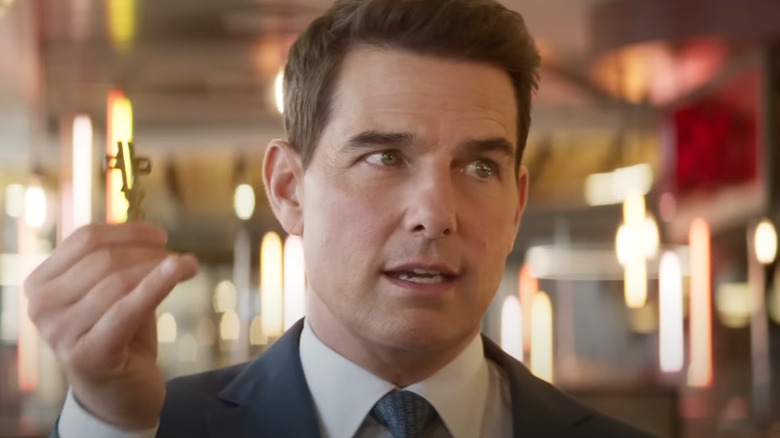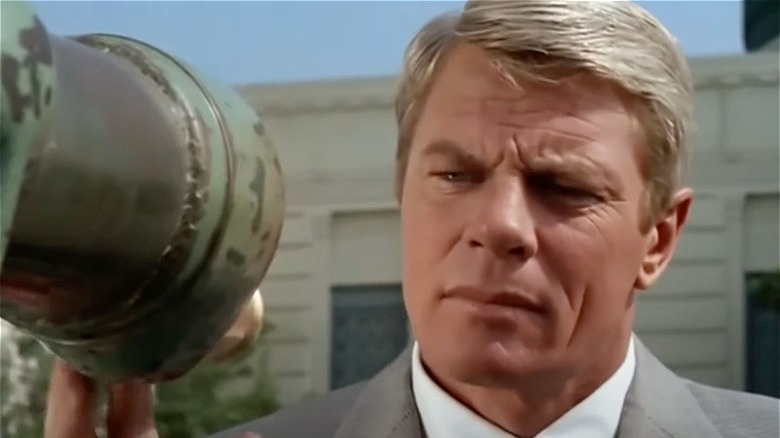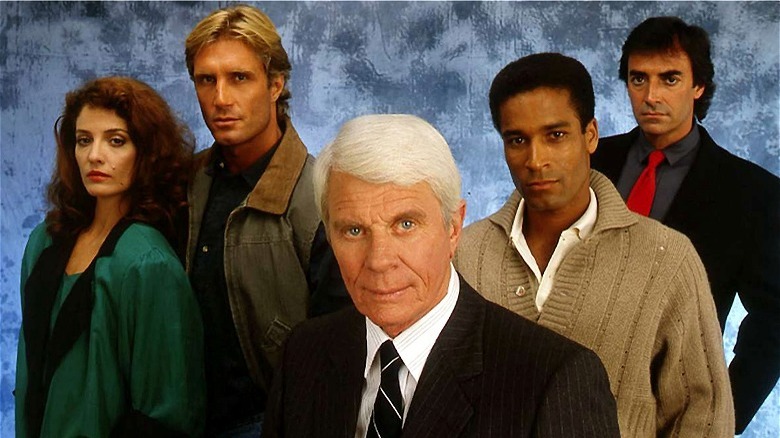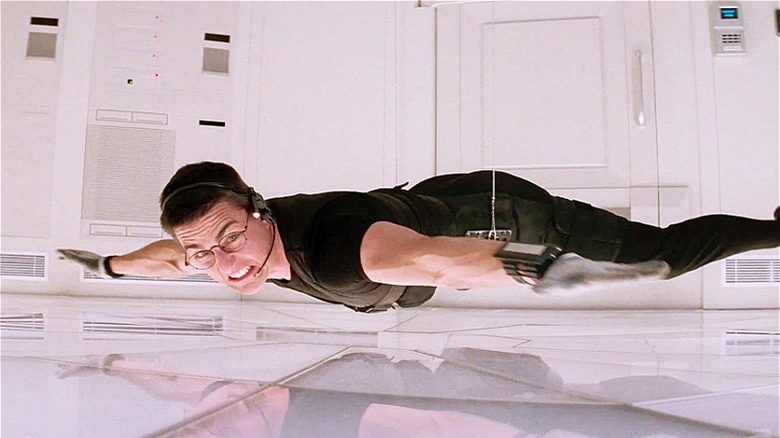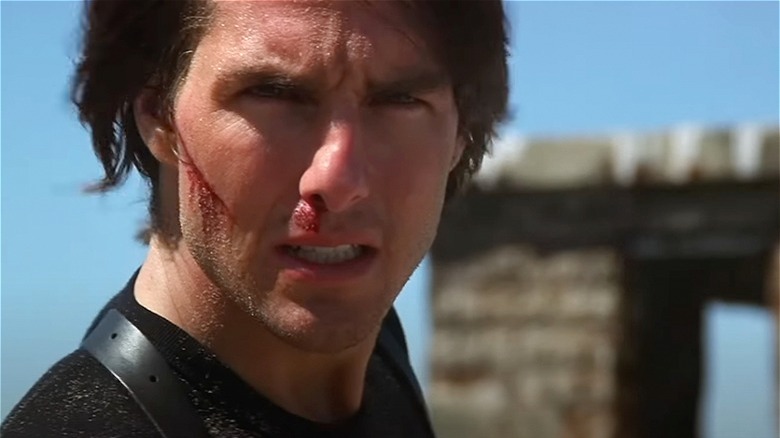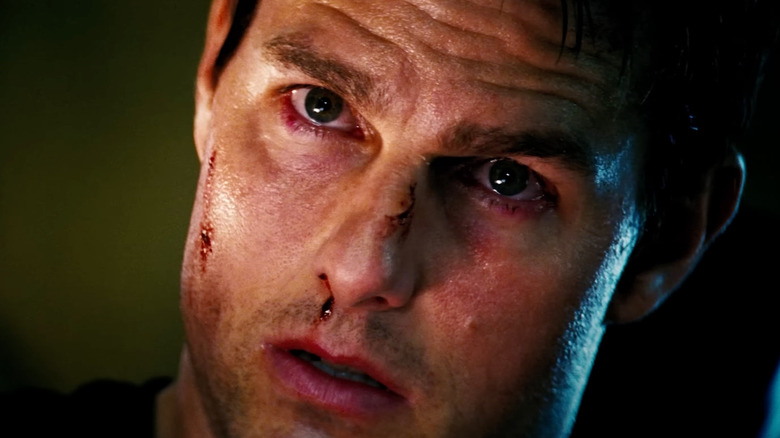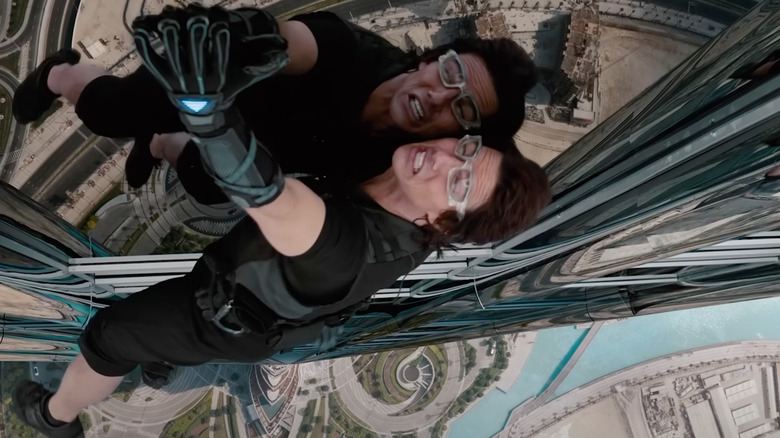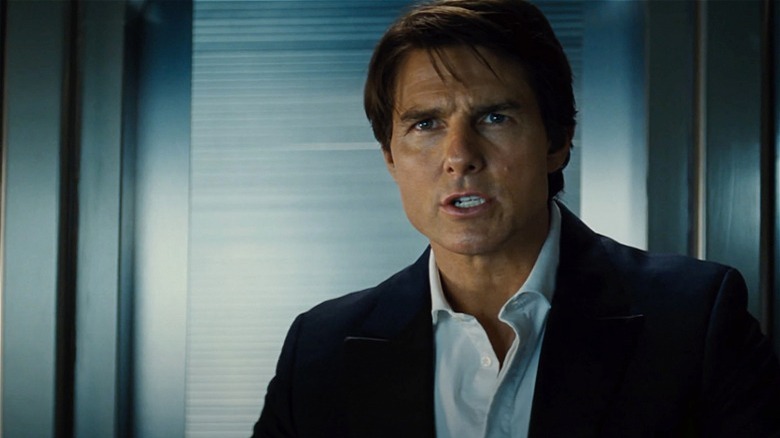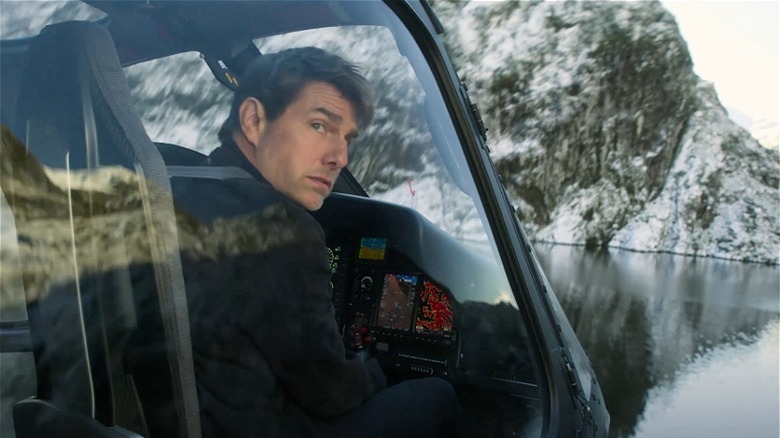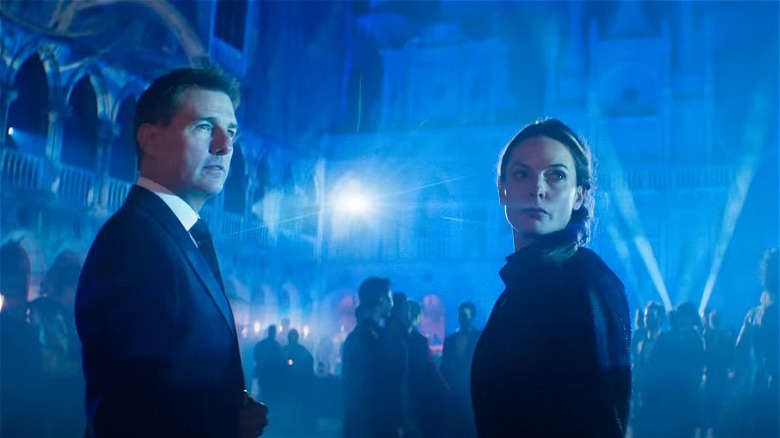The Correct Order In Which To Watch The Mission: Impossible Franchise
When the first "Mission: Impossible" film hit theaters in 1996, success seemed like a mission impossible. Directed by Brian De Palma and starring Tom Cruise, the initial movie brought the beloved 1960s TV series to the big screen with a fresh and action-packed approach. "Mission: Impossible" received positive reviews from critics and audiences alike, earning over $457 million worldwide and becoming one of the year's biggest hits. Mission accomplished.
Even more remarkably, this initial installment launched a long-running series of films: "Mission: Impossible II" (2000), "Mission: Impossible III" (2006), "Mission: Impossible – Ghost Protocol" (2011), "Mission: Impossible – Rogue Nation" (2015), "Mission: Impossible – Fallout" (2018), and "Mission: Impossible – Dead Reckoning Part One." Each film offered a unique take on the franchise's formula, though they primarily served as showcases for Cruise's extraordinary talent for thrilling stunts.
With so many chapters to explore, it's easy to become overwhelmed by the intricate web of spies and double-crossers spun by Cruise's iconic character, Ethan Hunt, and his IMF team. But fear not, for we are here to guide you through this perilous world and help you navigate the "Mission: Impossible" franchise with precision. Your mission, should you choose to accept it, is to read the following article before it self-destructs. Good luck!
Mission: Impossible (1966-73)
Fun fact: "Mission: Impossible" didn't always revolve solely around Tom Cruise's stunt work. While older folks are acquainted with the series' origins, younger audiences might be unaware that the spy saga originated on the small screen in the late 1960s. The popular TV show, which aired from 1966 to 1973, introduced iconic elements such as Lalo Schifrin's incredible theme and those mind-boggling masks. Starring Barbara Bain, Greg Morris, Peter Graves, Martin Landau, and even Leonard Nimoy for a time, the show followed the IMF's dangerous missions mounted under the leadership of Jim Phelps. These missions required precise execution and a fair share of luck to achieve positive outcomes.
That's why there was significant discontent among fans after the release of the original "Mission: Impossible" film in 1996, which abruptly killed off Mr. Phelps (portrayed by Jon Voight) and depicted him as a villain. According to Landau, his co-star Graves was unhappy with how his character was portrayed, and many cast members refused to appear as a result. Landau revealed to MTV, "When they were working on an early version of the first one — not the script they ultimately used — they wanted the entire team to be destroyed, done away with one at a time, and I was against that. It was basically an action/adventure movie and not 'Mission.'"
Nevertheless, fans of the film series would benefit from investing some time in the classic TV show to appreciate its contributions.
Mission: Impossible (1988-90)
After its cancellation in 1973, "Mission: Impossible" faded into obscurity until ABC decided to revive the series in the late 1980s. Peter Graves reprised his role as Jim Phelps, now overseeing a new team of agents portrayed by Thaao Penghlis, Tony Hamilton, Phil Morris (the son of Greg Morris), Terry Markwell and Jane Badler.
While this revamped version of "Mission: Impossible" offered entertaining upgrades from the 1960s series, it mostly recycled elements and episodes from its predecessor, such as "The System," "The Killer," and "The Legacy," with a few new tweaks added for good measure. The show introduced a range of unique gadgets and featured plenty of twists and turns. While it's not necessary viewing material, it's worth watching as a precursor to the later big-screen adaptations. For those who want to delve into the franchise, starting with the original series and then transitioning to the 1996 film "Mission: Impossible" would be the recommended path. However, if one chooses to watch the 1988 iteration, this would be the appropriate place to do so — after the original show and before the first movie.
Mission: Impossible (1996)
Several years after the rebooted TV series failed to gain traction, Tom Cruise and his producing partner Paula Wagner took charge and collaborated with renowned director Brian De Palma to develop a feature-length film. The result was a twisted, complex, and intelligent spy thriller featuring captivating performances from Cruise and his co-stars Jon Voight, Emmanuelle Béart, Ving Rhames, and Vanessa Redgrave, complemented by an incredible musical score from composer Danny Elfman.
In "Mission: Impossible," we are introduced to Ethan Hunt (Cruise) as he embarks on a mission to intercept a disk containing the CIA NOC list. When the operation goes awry, leaving Ethan and Claire (Béart) as the only survivors and accused of being double agents, they must go rogue to clear their names and apprehend those responsible for framing them.
This film sets a different tone compared to later entries in the series, with De Palma opting for a paranoid thriller instead of emphasizing action. While the middle section may drag a bit, the climactic sequence aboard a speeding train concludes the film on a strong note. Memorable set pieces such as the renowned CIA break-in, where Cruise skillfully hangs over a pressurized floor in complete silence for an intense 10 minutes, showcase both suspense and enjoyment. Notably, "Mission: Impossible" introduces Luther (Rhames), a recurring character in subsequent films, and Eugene Kittridge (Henry Czerny), who reappears in "Dead Reckoning."
Mission: Impossible II (2000)
"Mission: Impossible II" is often regarded as the weakest installment in the "Mission: Impossible" franchise. It deviates from the typical "Mission: Impossible" feel and fails to provide significant character development for our main protagonist, Ethan Hunt. Instead, it functions more like James Bond, and lacks the cleverness of its counterparts.
In this film, Ethan's mission involves stopping a madman named Sean Ambrose (Dougray Scott) from using a deadly virus for financial gain. To achieve his goal, Ethan recruits and falls in love with Nyah Nordoff-Hall (Thandiwe Newton), Sean's former lover, creating a complicated love triangle that adds some much-needed tension to the story. While Ethan assembles a team consisting of Luther and a helicopter pilot named Billy Baird, he predominantly handles the mission on his own. The film heavily revolves around Tom Cruise, with the actor stealing the spotlight and leaving little for his co-stars to do apart from admiring his character's greatness.
Directed by action maestro John Woo, "MI:2" features his signature style, which doesn't align well with the established "Mission: Impossible" formula. The film, as noted, embraces a more James Bond-like approach, with stunning car chases, stylized gun battles, extravagant explosions, and doves ... lots of doves (a typical Woo flourish). While the spectacle is undeniably entertaining, the film doesn't contribute significantly to the overall narrative of the franchise. As such, viewers could easily skip "Mission: Impossible II" and proceed directly to "Mission: Impossible III" without feeling like they've missed crucial plot or character developments.
Mission: Impossible III (2006)
After a significant gap, Tom Cruise teamed up with J.J. Abrams for "Mission: Impossible III," delivering a remarkable chapter that captured the essence of the original TV show. Here, Ethan Hunt retains his role as the primary leader and point man, but he also enlists the support of a colorful IMF crew consisting of Luther, Zhen Li (Maggie Q), and Declan Gormley (Jonathan Rhys-Meyers). Notably, the introduction of Benji, played by Simon Pegg, leaves a lasting impact and secures his place in later sequels. Together, this diverse team must work together to defeat Owen Davian, portrayed brilliantly by Philip Seymour Hoffman, who emerges as — and remains — one of the franchise's most memorable villains. Their mission is to prevent Davian from acquiring a mysterious device known as the Rabbit's Foot.
"Mission: Impossible III" offers well-executed action sequences, cleverly crafted set pieces, and the expected array of disguises, twists, and double-crosses. What sets this film apart is the emotional core that Abrams adds by emphasizing Ethan's relationship with his love interest, Julia, played by Michelle Monaghan. The film creates a more engaging narrative than any seen in the first two entries by elevating the personal stakes beyond the usual world-threatening scenarios. While Cruise doesn't perform any acts of derring-do here, he and Abrams work hard to make Ethan a character worth rooting for.
Mission: Impossible -- Ghost Protocol (2011)
Despite giving the franchise a fresh coat of paint, "Mission: Impossible III" didn't exactly ignite the box office, grossing just under $400 million worldwide — the least amount of money earned by any chapter in the series. No matter, five years later, Cruise returned with a fresh set of faces for Brad Bird's "Mission: Impossible – Ghost Protocol" and took the spy saga to dazzling new heights. Literally. This is the one where Cruise scales the Burj Khalifa and delivers the first of many insane stunts that now define the franchise. Oh sure, we marveled at the actor's rock-climbing and motorcycle abilities in "Mission: Impossible II," but seeing Cruise scale the 160-plus story building remains a thrilling spectacle to behold more than a decade later.
As for the rest of the film, "Ghost Protocol" lacks the energy of its predecessor or the psychological intrigue of Brian De Palma's original, but there's still plenty to admire here. Bird ensures supporting players like Benji, Brandt (Jeremy Renner), and Carter (Paula Patton) meaningfully contribute in the exercise, allowing them to connect with Ethan personally. On a negative note, the villains, played by Michael Nyqvist, Samuli Edelmann, and Léa Seydoux, fail to leave much of an impression, and the plot feels rather rudimentary.
No matter, "Ghost Protocol" introduces elements that figure prominently later on, making it a pivotal entry for fans of the franchise.
Mission: Impossible -- Rogue Nation (2015)
"Mission: Impossible – Rogue Nation" remains my favorite franchise entry thus far. Brimming with hard-hitting fight sequences, a smartly executed plot, incredible stunts, and Joe Kraemer's pulse-pounding score, the fifth installment in the venerable spy series rates as an absolute blast from start to finish. Here, everything comes together and forms a masterful piece of popcorn entertainment that gets better with each viewing.
Returning cast members Cruise, Pegg, Renner, and Rhames provide important continuity, but Rebecca Ferguson serves as the film's secret weapon. She swoops in and all but steals the show as the resourceful and cunning Ilsa Faust. The actress shines alongside Cruise and creates a nuanced character that has understandably become an audience favorite. Ilsa works for Solomon Lane (Sean Harris), a former MI6 agent man hellbent on assembling a terrorist organization known as The Syndicate. Naturally, Ethan must stop Lane before he attains the resources necessary to complete his devious plan, all the while evading CIA director Alan Hunley (a wonderful Alec Baldwin), and disregarding his obvious attraction to Ilsa.
Under the direction of Christopher McQuarrie, "Rogue Nation" represents the pinnacle of the "Mission: Impossible" series. The film opens with a breathtaking prologue featuring Cruise hanging from the side of an A400M cargo plane, setting the stage for the thrilling action that follows. From a high-speed motorcycle chase to a tension-filled finale, this sequel delivers on all fronts, leaving audiences thoroughly satisfied. With key characters like Ilsa, Luther, Benji, Lane, and Hunley carrying over to the next installment, this is one mission you definitely must accept.
Mission: Impossible - Fallout (2018)
How do you top a sensational movie like "Mission: Impossible – Rogue Nation?" Why, you produce "Mission: Impossible – Fallout," of course, better known as the one where Tom Cruise broke his foot whilst jumping from a roof. This is also the chapter where the daredevil actor leaps onto a helicopter and risks his life all for our entertainment.
While "Fallout" may not surpass "Rogue Nation" in terms of overall quality due to some plot contrivances and the handling of Henry Cavill's character, August Walker, no one can deny the jaw-dropping action on display. Director Christopher McQuarrie and Cruise continue to push the boundaries of stuntwork, solidifying their place in cinematic history. The film's third act alone is a masterclass in sweat-inducing tension and exhilaration.
Cruise remains a magnetic presence, and Rebecca Ferguson shines as Ilsa Faust, even with a slightly reduced role. Simon Pegg and Ving Rhames bring heart and soul to their returning characters, Alec Baldwin impresses as the new IMF director, Sean Harris exudes villainy as Solomon Lane, and Vanessa Kirby adds intrigue as a mysterious handler. "Fallout" can be viewed as a direct sequel to "Rogue Nation," with plot points and character arcs that seamlessly flow into "Dead Reckoning," and aside from a few minor nitpicks, it remains one of the best action movies of the last decade.
Mission: Impossible - Dead Reckoning Part One
One fascinating aspect of each "Mission: Impossible" film is its ability to function as a self-contained story while leaving room for future installments. In the event of any film's failure, Tom Cruise could easily step away, content with the previous entry serving as a fitting conclusion to Ethan Hunt's journey. "Mission: Impossible III" sees Ethan heading into the sunset with Julia, seemingly retiring from his spy life. "Ghost Protocol" concludes with Ethan disappearing into the darkness, choosing to continue his IMF career alone. The final moments of "Fallout" allow Ethan to bid farewell to Julia and embrace his connection with Ilsa. While these endings are not definitive closures, they provide enough resolution for audiences to move forward.
However, with "Mission: Impossible – Dead Reckoning Part One," the franchise presents its first two-part story, with the second half set to release in Summer 2024. Once again, this ambitious new chapter, centered around concerns about artificial intelligence, provides its own self-contained adventure. Yet, that hasn't stopped Christopher McQuarrie and Tom Cruise from teasing plans for a ninth installment. How long can they continue this journey? It doesn't matter, as long as the quality remains consistently high.
At some point, it would be enjoyable to witness the return of every surviving hero and villain from the franchise for a grand finale akin to "Avengers: Endgame." Who would be crazy enough to turn down that mission?
